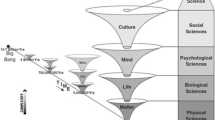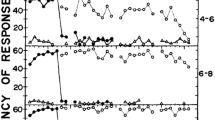Abstract
Like all natural sciences, behavior science has much to offer toward an understanding of the world. The extent to which the promise of behavior science is realized, though, depends upon the extent to which we keep what we know before us. This paper considers fundamental concepts in behavior science, including the concepts of behavior, stimulation, setting conditions, and language. In considering these concepts, we revisit comments from B. F. Skinner and J. R. Kantor and also consider some areas of behavior analytic research and the implications they have for reconsidering long-held assumptions about the analysis of behavior. We hope that, in considering our foundations, the vitality and strength of the discipline might be enhanced, our impact on science improved, and our future secured.
Similar content being viewed by others
Notes
The term “function” here is roughly synonymous with “action” as we have been using this term. It refers to the participation of stimulation in a mutual and reciprocal relation with responding.
Importantly, while we acknowledge that behavior analysts have provided a number of ways to interpret various phenomena (e.g., Hayes et al. 2001; Sidman 2000; Tonneau 2001), Kantor’s conceptualization of stimulus substitution seems to be the most consistent with the aims we have described thus far, and a detailed consideration of the various theories on this topic is far beyond the scope of the current paper.
References
Baron, A., Perone, M., & Galizio, M. (1991). Analyzing the reinforcement process at the human level: can application and behavioristic interpretation replace laboratory research? The Behavior Analyst, 14, 95–105.
Baum, W. M. (2013). What counts as behavior: the molar multiscale view. The Behavior Analyst, 36, 283–293.
Dymond, S., & Rehfeldt, R. A. (2000). Understanding complex behavior: the transformation of stimulus functions. The Behavior Analyst, 23, 239–254.
Fryling, M. J., & Hayes, L. J. (2009). Psychological events and constructs: an alliance with Smith. The Psychological Record, 59, 133–142.
Fryling, M. J., & Hayes, L. J. (2011). The concept of function in the analysis of behavior. Mexican Journal of Behavior Analysis, 37, 11–20. doi:10.5514/rmac.v37.i1.24686.
Hayes, L. J. (1992). The psychological present. The Behavior Analyst, 15, 139–145.
Hayes, L. J. (1998). Remembering as a psychological event. Journal of Theoretical and Philosophical Psychology, 18, 135–143.
Hayes, L. J. (2001). Finding our place in a constructed future. In L. J. Hayes, J. Austin, R. Houmanfar, & M. C. Clayton (Eds.), Organizational change (pp. 349–372). Reno: Context Press.
Hayes, L. J. (2013). Theory and philosophy: future directions. The Behavior Analyst, 36, 373–374.
Hayes, L. J., Adams, M., & Dixon, M. R. (1997). Causal constructs and conceptual confusions. The Psychological Record, 46, 97–111.
Hayes, L. J., & Delgado, D. (2005). Transgenic and knockout models: the problem of language. In G. Fish & J. Flint (Eds.), Transgenic and knockout models of neuropsychiatric disorders (pp. 45–67). Towanta: Humana.
Hayes, L. J., & Delgado, D. (2007). Animal models of non-conventional human behavior. Behavior Genetics, 37, 11–17. doi:10.1007/s10519-006-9126-z.
Hayes, L. J., & Fryling, M. J. (2009a). Overcoming the pseudo-problem of private events in the analysis of behavior. Behavior and Philosophy, 37, 39–57.
Hayes, L. J., & Fryling, M. J. (2009b). Toward an interdisciplinary science of culture. The Psychological Record, 59, 679–700.
Hayes, S. C., Barnes-Holmes, D., & Roche, B. (2001). Relational frame theory: a post-Skinnerian account of human language and cognition. New York: Kluwer Academic/Plenum.
Kantor, J. R. (1924). Principles of psychology (Vol. I). Bloomington: Principia Press.
Kantor, J. R. (1950). Psychology and logic (Vol. II). Chicago: The Principia Press.
Kantor, J. R. (1953). The logic of modern science. Chicago: Principia Press.
Kantor, J. R. (1958). Interbehavioral psychology. Chicago: Principia Press.
Kantor, J. R. (1977). Psychological linguistics. Chicago: The Principia Press.
Kantor, J. R., & Smith, N. W. (1975). The science of psychology: an interbehavioral survey. Chicago: The Principia Press.
Marr, M. J. (2013). Theory and philosophy: Themes and variations. The Behavior Analyst, 36, 193–195.
Parrott, L. J. (1983a). Similarities and differences among Skinner’s Radical Behaviorism and Kantor’s Interbehaviorism. Mexican Journal of Behavior Analysis, 9, 95–115.
Parrott, L. J. (1983b). Systemic foundations for the concept of ‘private events’. In N. W. Smith, P. T. Mountjoy, & D. H. Ruben (Eds.), Reassessment in psychology: the interbehavioral alternative (pp. 251–268). Lanham: University Press of America.
Parrott, L. J. (1984). Listening and understanding. The Behavior Analyst, 7, 29–39.
Parrott, L. J. (1986). On the role of postulation in the analysis of inapparent events. In H. W. Reese & L. J. Parrott (Eds.), Behavior science: philosophical, methodological, and empirical advances (pp. 35–60). Hillsdale: L. Erlbaum Associates.
Rachlin, H. (2013). About teleological behaviorism. The Behavior Analyst, 36, 209–222.
Sidman, M. (2000). Equivalence relations and the reinforcement contingency. Journal of the Experimental Analysis of Behavior, 74, 127–146. doi:10.1901/jeab.2000.74-127.
Skinner, B. F. (1938). The behavior of organisms. New York: Appleton-Century-Crofts.
Skinner, B. F. (1957). Verbal behavior. New York: Appleton-Century-Croft.
Tonneau, F. (2001). Equivalence relations: a critical analysis. European Journal of Behavior Analysis, 2, 1–33.
Author information
Authors and Affiliations
Corresponding author
Rights and permissions
About this article
Cite this article
Hayes, L.J., Fryling, M.J. A Historical Perspective on the Future of Behavior Science. BEHAV ANALYST 38, 149–161 (2015). https://doi.org/10.1007/s40614-015-0030-9
Published:
Issue Date:
DOI: https://doi.org/10.1007/s40614-015-0030-9




